#retroclone ttrpg
Explore tagged Tumblr posts
Text
#roleplaying games#rpg polls#tabletop roleplaying games#ttrpg#ttrpgs#independent ttrpg month#indie ttrpg#retroclone ttrpg#labyrinth lord#swords and wizardry#whitehack#osric#ose#old school essentials#retroclone
1 note
·
View note
Text
Sometimes I think I want to do a retroclone of an RPG, but one that's not a D&D. JK's Mutants in the Now of course, does this for a certain mutant animal rpg, but what I want to do is nowhere near as cool.
I want to do a retroclone of some of the incredibly janky "This came out of wargame publisher trying to get on the bandwagon and just writing their rules for an RPG like they did the wargames."
Four columns of text per page. Decimalized section headings where you've got to go to 14.3.1 to get to the magic rules and the rules for character advancement are buried 25.7.2 and vaguely imply that you can spend downtime days working out to earn XP and in fact, that may be more efficient than going on adventures with the default reward scheme for them. Whole sections of the magic rules based on the Goetia or some old "magical properties of herbs and gemstones" stuff.
I'm talking SPI's Dragonquest. I'm talking POWERS AND PERILS. Maybe a little bit of Tunnels and Trolls, even, though that was a lot more explicitly "This is our D&D houserules as a game"
And don't get me wrong, there's some fun ideas buried in these. No classes, but broad skills is common to a lot of them. Dragonquest ditches mental attributes entirely; there's no int or wisdom, just 'magical aptitude' and you're explicitly encouraged to tank your magical aptitude if you don't want to be a magician; setting it as low as it can be means you get a bonus to your magic resistance, making it one of the first games to consider 'Hey what if there were upsides to minimizing an ability"
(This fun stuff is often buried under a crust of weird biotruth opinions, but it's still there.)
But first, I'm going to finish Hollywood Underhills. Probably.
1 note
·
View note
Text
I run this foir my Monday ttrpg group and they love it. I
The blend of macabre and whimsical appealed to my group's "Nice Churchgroup With A Dark Sense Of Humor" sensibilities. It leaned well into the campaign's premise of "P.G. Wodehouse's supporting cast enters an Otherspace on a lark", and the ongoing escapades of the Girl Scout Leader, Neighouring Handyman and Eccentric Estotericist Cousin Obsessed With Egyptian Wisdom are proving delightful. The oddities we all find as the decend into this strange library are steeped in that OSR aesthetic, remaining coherent, absurd, and delightfully grotesque in wasy that that nevertheless remain on the right side of Good Taste.
The random room generation is a constant source of delight, taking an hour or so of preparation to create twelve detailed rooms that have so far lasted roughly six 3-hour sessions of play from. As my party continues to to explore and fumble through the candle-lit, musty shelves of The Library, the unfolding randomness created by a truly strange menagerie of creatures and personalities remains as delightful as it is outlandish.
The portability to any OSR or d20-adjascent property makes good use of this, make it an easy sell for any group used to moreconventional D&D games. (I am using Beyond the Wall for the baseline experience, with only marginal hiccups). The experience of playing something like this takes a little getting used to (remembering to track Progress and pay attention to the Depth - flow charts and google docs are advised!), and the experience of coming to this is distinct from players more used to something robust (some would say bloated) as Curse of Strahd or Waterdeep: Dragon Heist.
Overall, however, I love this product. My friend Bill gifted me this for Chirstmas a few years ago, and it proved to be part of what helped me trusly understand why people were drawn to OSR style games. The elegant simplicity of the creature stats, the omnipresent presence of Depth, the fantastic commitment to tone - it's all here. Highly recommended, The Stygian Library remains one of the best gaming products I've read in years.
Send my regards to Librarians, and beware the Bandersnatch!

The Stygian Library by Emmy Allen
A procedurally-generated library dungeon set in the extra-dimensional space between every library in the universe. Each expedition generates its route as it explores, resulting in new locations and forbidden knowledge being discovered with every visit.
#indie ttrpgs#OSR#retroclone#D&D#The Stygian Library#Dungeons and Dragons#DnD#ttrpgs#tabletop#ttrpg community#ttrpg stuff#roleplaying games
68 notes
·
View notes
Note
Hello! 😃👋 I would love to know your top ten favorite solo ttrpgs! I’m looking to discover more! Thank you!
I'm not sure I have ten favorite ttrpgs that are explicitly solo ttrpgs, but Loner: Another Solo RPG, 3rd Edition is probably my favorite solo ttrpg. I'm also a big fan of Ironsworn.
I play traditional and retroclone games with the Mythic Game Master Emulator, 2nd Edition. My personal preferences are gritty, heroic fantasy, and OSR (Old School Rules or Old School Renaissance).
My Top Ten list would look something like this:
1. Loner: Another Solo RPG, 3rd Edition
2. Ironsworn
3. Iron Falcon Rules for Classic Fantasy Role-Playing
4. Basic Fantasy Role-Playing Game, 4th Edition
5. Cairn, 2nd Edition
6. BECMI Dungeons & Dragons
7. Advanced Dungeons & Dragons, 2nd Edition
8. OSRIC
9. White Box Medieval Fantasy Adventure Game
10. Savage Worlds
These are games that I own but haven't had the chance to solo yet:
1. Blades in the Dark
2. Ker Nethalas: Into the Midnight Throne
3. Ruthless Heavens, Boundless Fate
4. FantasyAGE
5. Starforged
Thank you for your question!
56 notes
·
View notes
Text
The Two D&Ds
I am going to make two statements:
I despise D&D, and consider it a parasitic drain on ttrpgs as an artform.
I love D&D and my fascination with it continually inspires me to create art using it.
These two statements might seem to be at odds, but in fact there is no conflict when one considers that the term 'D&D' is being used to refer to two completely different things. I hate one of those things and like the other. So let's unpack that. Firstly, there's D&D-as-a-lifestyle-brand. D&D as presented by critical role, by memes about horny bards and wholesome gay tiefling found families, and by the wider hasbro-sanctioned fandom. Where the actual design and mechanics of the game are a vague suggestion that exists homeopathically in the same vicinity as what you're doing. But really, you're inventing blorbos, collecting pretty dice, and speculating on events in an actual-play on twitch; the rules in that very pretty rulebook are an afterthought to the fandom.
Then there's D&D-as-a-family-of-ttrpg-mechanics. This covers the various editions of Dungeons & Dragons - from the white-box OD&D to 5th edition and everything in between - as well as various retroclones, hacks and spin-offs such as the OSR, Pathfinder, etc. This isn't defined as a cultural space; it's a set of game mechanics and design principles shared across the text of various games. And there's a lot of variation with the specifics, but like The Blues, if you know the basic structure it all makes sense.
The two D&Ds have very little to do with each other.
When indie people like myself criticise D&D, we are usually criticising the first one. We're generally outsiders to that fandom-space who are unhappy with the way that fandom encroches on, and ultimately stiffles, everything else in ttrpgs as an artistic medium. We tend also to dislike the very shallow interest in that fandom of the things we care about in ttrpgs - game design, gameplay, theory, criticism, etc.
Here's the thing. I am, personally, immensely critical of D&D-as-lifestyle-brand. I detest it, honestly. It strikes me as a corporate exploitation of the wider medium in pursuit of an easy profit, at the expense of catering to the lowest common denominator. Like invasive kudzu, it chokes out all ecological diversity in the art-form. Its a homogenising influence, and in my experience pretty anti-intillectual.
Because, at risk of sounding like a pseud, I consider ttrpg design to be an art-form that merits serious effort, discussion and appreciation.
However. D&D-as-a-set-of-games I actually quite like. I find myself fascinated by the way so many games take apart the starting framework of a given edition of D&D - like your 12-bar-blues structure - and adapt it and riff on it and fuse it with other genres. I find it interesting to track the way whole movements and genres mutate out from that starting position. Hell, I do that myself, a lot. A lot of my design work takes the very early editions of D&D as a starting point, gets into a groove, and riffs on it until it's seemingly unrecognisable.
To me, a work like Mork Borg is D&D (the second definition). It is, however, totally unrelated and unrecognisable to D&D (the first definition).
So I will talk about "D&D as the containment game for shit players" and I mean it, because I'm talking about type-1. And I'll do that while designing a paleolithic OSR game, because that's type-2. And by and large, all that happens when both those things intersect is people get upset.
344 notes
·
View notes
Text
The Ruins of Castle Gygar
NOW ON KICKSTARTER!

The Ruins of Castle Gygar is a 360+ room megadungeon designed for old school tabletop RPGs. It is designed with Old-School Essentials in mind but will play great with any OSR B/X compatible game, your favourite retroclone, five-ee, or fantasy heartbreaker.
The Ruins of Castle Gygar began as a #Dungeon23 project that I completed over the length of 2023. The #Dungeon23 project was an initiative to write one dungeon room a day every day for 2023, and I completed it! I then spent the next six months digitizing my notebook, refining it into a useable, runnable megadungeon.
Castle Gygar is inspired by many things, such as the original Greyhawk dungeon by Gary Gygax, the structure of the megadungeon in Nethack, as well as the maze structure dungeons of the classic Wizardry computer games.
PLEDGE NOW! Or, click below for more info!
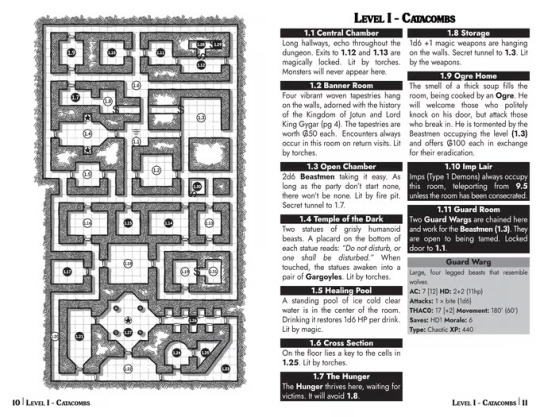
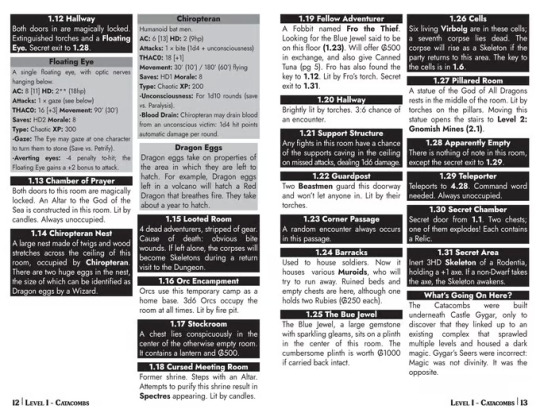
Download a free preview here!
The Ruins of Castle Gygar will be a 64 page, 8.5" x 5.5" black-and-white staple bound zine-style book with laminated soft-touch cover, printed in the USA by Mixam. It'll be on 60lb paper so it'll be nice and thin. We'll be shipping it from the United States, and each order will be hand-packed with love.
The book is written by Onslaught Six and features cover art by Chaoclypse and will be edited by Ennie award winner Roz Leahy. The book currently has all text written and layout conventions established, and awaits editing, a layout pass and (depending on budget) additional art. Then we'll be able to go to printing and distribution.
Thank you so much for your support. We wouldn't be able to keep making TTRPG stuff without you. We sincerely thank each and every one of you who's ever donated to our Kickstarters, or bought our books. Your support is vital to us continuing to make dope shit.
PLEDGE ON KICKSTARTER NOW!
26 notes
·
View notes
Note
what r ur top 3 ttrpgs?
Oh that's a really tough one! I know what two of them are but it's the third one that's giving me trouble. Oh, okay, I've got it now! These are in no particular order because ultimately these are all very different types of games for different purposes.
Rolemaster. Big surprise there. Rolemaster is kind of a crunchy mess but I am extremely fond of it. It's a game that requires a lot of investment because character creation is very intensive. But once you start rolling on those tables, hoo baby. It's good. Every attack, every spell, every maneuver is a chance for some extremely random bullshit to happen and completely throw everyone's plans off balance, and that unpredictability and randomness is what I adore about TTRPGs.
Monsterhearts. This PbtA game of playing horny fucked up teenage monsters is a masterpiece of design and genre emulation. It is like if you threw Jennifer's Body, Ginger Snaps, the Vampire Diaries, and Carrie in a blender and made an RPG out of the resulting sludge. Strangely enough, I don't think it's necessarily the best PbtA game: I think Apocalypse World is still the best in that regard. But Monsterhearts as a whole is so explosive and melodramatic and powerful.
Basic/Expert D&D: I'm not entirely a D&D hater and I actually think TSR D&D was really good at times! The Basic/Expert set (specifically the 1981 version) is one of my favorite RPGs ever because it is ultimately a simple dungeon game that does everything it needs to do! And like, it is also a very silly game where Elf and Dwarf and Halfling are classes and the look and feel is a weird mix of like guys in proper medieval attire and then there's also like a Magic-User in star-spangled pajamas. It, or Old School Essentials, a modern retroclone of it, is my go-to system when I want to run the dungeon game.
Honorary mentions: AD&D 2e, D&D 3.5, D&D 4e, Warhammer Fantasy Roleplay 2e, Apocalypse World, Godsend, Traveller 1e, Paranoia 1e, Fellowship, etc. etc.
35 notes
·
View notes
Text
Holmes Basic Rebirth 1: The Wandering Graveyard of Kargash-Mir

Dr. J. Eric Holmes with a few of his D&D Figures, 1979. [DM Note: someone convinced me to go back to basics, since I was experiencing one of my (sadly, all too frequent) solo gaming slumps. The suggestion felt extreme: not reverting to an OSR retroclone, but reaching all the way back to the origins of the hobby. Retroclone reinforcement has sometimes been a successful strategy for restarting my creative solo RPG engagement the past. But it hasn't seemed to work more recently. In fact, "retroclone burnout" has left me a bit distressed, compounding my sense of disconnection. Feeling desperate, I decided to take the back-to-basics advice as far as I could, starting a short campaign with the Holmes Basic D&D blue book from 1977. I'm pleased to say it worked, and I've recaptured my sense of wonder, creativity, and fun. Of course, as someone with about 40 years of RPG experience, I can go back to basics, but I can't deny all the innovations and interesting evolutions of TTRPGs since then. So I've also incorporated numerous solo tools, supplements, etc. into this session. For fellow gamers, who like to look at the technical side, I'll link what I'm using below. Thank you for reading! ]
Technical TTRPG Profile:
Dominant Rule Set: Holmes D&D Basic Set (1977) - note that Hasbro-WotC has decided to disappear this rule set in favor of other versions of the Basic Set, but this version is special, perhaps because it demonstrates more than any others how player imagination—as opposed to insidious subscription models, aggressive branding, and corporate meddling—can create great experiences. Read about Holmes Basic here: https://sites.google.com/site/zenopusarchives/. If you look around, you should be able to find a free PDF of it online. I would revert to the Moldvay-Cook D&D Basic Set Rulebook if I could not find a copy of Holmes. But I highly recommend Holmes as a way to get back in touch with the raw power of fantasy roleplaying.
Setting: Ondaris.
Solo Gaming Structure: Trey: Solo Roleplaying.
Oracles and Tables: Old School Revival Solo Role-playing Guide; Loner: Steel & Sorcery; Tales of Argosa.
Starting Equipment: "fast packs" from Dragonslayer.

The Story: three childhood friends, Iovis (fighting man), Ruvin (magic user), and Dain (thief—in this case, a military scout), return to their hometown of West Withly after three years of professional training in their respective guilds (Iovis, with the Semlohe Mercenary Guild; Ruvin with the Tower of Xolark in Misty Harbor; and Dain with the Rivercross Confederation of Guides and Scouts).
In Ondaris, one apprentices with a local practitioner of an art and then serves in a guild for three years at a time with one-year stints back home to serve one's community and pay one's initial master back.

While catching up over ales at the Inn of the Blue Dragon, they're approached by a group of town aldermen, who offer them 80 gold for rescuing the mayor, Joco Havlish, and his mistress Sareena, both of whom are being held hostage by the ruthless ogre, Drazrur Blackbite. The ogre is said to keep his lair in the northeastern foothills beyond the Beast River. Though the precise location of his cave has never been established.
Recently, Blackbite snuck up under cover of darkness and hammered down a crude wooden sign, affixed to the pole of a nidstang and written in blood, demanding a tribute of 50 sheep and five virgin girls lest he execute the hostages. Obviously, this is unacceptable; though, local heroes willing to fight an infamous ogre, who understands curse magic, are in short supply.

(A typical Ondarissian Nithing Pole used for cursing and sometimes making a very serious point to one's neighbors.)
Seeing this as a fitting way to begin their year of professional practice back home and establish a reputation, Iovis, Ruvin, and Dain obtain permission from their families and former masters and accept the offer.

They provision themselves and set out to find the ogre. The Beast River is half a day to the northeast on foot. They go quickly over the flat grasslands and have no encounters or problems on the way except for sighting a brightly dressed gnome sailing past on a raft. The odd creature waves at them and shouts that they should turn back "before the spirits rise." They have no clue what he's talking about, but it doesn't sound good.
The day is almost finished when they reach the beginning of the foothills, known locally as Zaphod's Reach, due to tower of the ancient mage, Zaphod Zaphodinteries, which supposedly stood there in the times before the Scarring of Ondaris. Now there is nothing but a perpetual chill mist hanging a few feet over the ground and dark foothills extending to the limits of sight. Not wanting to face anything in the night and tired from their journey, the three friends make camp on the northern bank of the Beast.
In the morning, they realize (strangely, since it was not there the night before) that they have been camping in a graveyard. It's one of the wandering graveyards of Kargash-Mir. Ruvin, in his lore studies in the Tower of Xolark, learned about the wandering graveyards. He explains them to Iovis and Dain over breakfast.

They are an inexplicable fact of life throughout the land. Sometimes, a graveyard will "wake up" and animate itself the same way "naturally occurring" undead in Ondaris will sometimes rise from their graves.
When an entire graveyard wakes and starts to move, it is considered a "Kargash-Mir," essentially a "beast of graves" in the old language of the Beastmen. As a Kargash-Mir travels, it will absorb any other graveyard it comes into contact with and grow proportionately larger. Sometimes they move on a "circuit," appearing in a the same places over time. This one apparently stretches for miles.
Such wandering graveyards are said to contain all manner of dark fae, undead, and sometimes even deep crypts, dungeons, and fragments of towns (even cities) lost to the knowledge of men. Twisted demonic creatures, like ogres, blood orcs, ur-goblins, soot trolls, gnolls, and dragons are also said to live in them. For time runs differently in a Kargash-Mir and old things, long passed away, are ever present there.
Ruvin begins to explain the metaphysical theories involved in an entire graveyard animating and silently shifting through the landscape, but Iovis and Dain are worried. If the ogre, Drazrur Blackbite, has his lair in a Kargash-Mir, it means this one probably moves in a set pattern. It means they're going to have to explore the place in the not-so-certain prospect of finding his lair. And it means the ogre is naturally protected by whatever other nasty creatures may be calling the place home. Still, they have little choice. So they forge into the graveyard, feeling trepidatious but determined.
They move through the seemingly endless, dank, and misty Kargash-Mir for what feels like the better part of a day, encountering nothing but headstones, mausolea, and crypts. Dead trees hang their brittle branches against the darkened sky and crisp leaves crunch on the twisting pathways.
Eventually, they do encounter a giant death's head moth—a predator that may have been hunting them for some time. Its wingspan is at least six feet wide and it rises up suddenly from behind a cluster of headstones, wailing the Acherontian death dirge that can burst the heart of a grown man.

These highly intelligent flesh-eating hunters are found throughout the dark places of Ondaris, but especially in graveyards, where they feel most at home, secreting their vile nests in empty crypts, where they drag their victims to be fed upon for weeks.
Iovis is affected by the moth's mournful cry and loses all self control, running off between the crypts. Ruvin is also affected, paralyzed to the spot, unable to speak or move. Only Dain resists the affects of the death dirge. He raises his light crossbow, fires, and hits the creature in its furry abdomen.
The dirge immediately stops and the creature flaps around to face Dain. It has an unnaturally human face with red eyes. Its fangs drip yellow bile and venom. You have killed me, it sputters, but you'll not escape this boneyard intact! Then it drops to the earth, its body immediately beginning to steam and melt into the pure black sludge of elemental evil of which it is composed.
Dain shakes Ruvin out of his terror-stricken paralysis and shouts that they need to find Iovis, who has disappeared into the mist . . .

9 notes
·
View notes
Text
>~/ttrpgs/retroclones/pendragon
what do you mean by this??
5 notes
·
View notes
Text
Since I am still chewing on the DIE Stapling post, I am going to do another about effort mechanics in ttrpgs because I am trying to write that Blasphemous inspired Trophy Gold hack (placeholder name: Penance). And one of the coolest mechanics for Trophy is its Risk Roll, which is basically an effort mechanic.
"But, Ampersand, what is an effort mechanic?" I hear you ask, dear mutual I am making up in my head. An effort mechanic allows you to reroll an action you have already attempted but failed or to get a bonus to a roll at the expense of some resource. Usually, that resource being the character's health. But it can also be something else like clues in an investigative game or even a narrative consequence (but that's usually called a Devil's Bargain).
The important part is that it gives a benefit but requires a sacrifice. And that's when the whole fanfare of psychoeconomics start. Because you need the sacrifice to be big enough to give the player pause and not use it every roll. And also you need the benefit to be significant enough to make it worth the risk and the expense. If properly adjusted, an effort mechanic can become a slow but sure spiral into the characters downfall.
Let's look at some examples!
Numenera is the first system I learn that had such a mechanic (but certainly was not the first ever). It is pretty straightforward in its implementation, too. You spend a fixed amount of the appropriate life pool and you get to reduce the difficulty of a task. Easy enough. But Numenera, being a tradgame as it is, the power creep upends any weight of the sacrifice. Once you level up enough, your pools become deep enough as to make effort something to just add to whichever skill roll you thought it needed a bit more oomph. This is not something wrong per se, but it can easily make your characters overly competent!
On the other hand, there's Dungeon Crawl Classics. DCC is a peculiar OSR game in that it is a really spiced up retroclone, wriggling DnD B/X ruleset to a point where it is almost unrecognizable. I am sure there are plenty effort mechanics peppered in the text, but I want to point out its magic system because I absolutely adore it. To be a wizard in DCC requires active dedication. That is because almost every spell has a writeup of about an A4's length, filled with the various effects a spell may have once the dice is rolled. And the effect can be wildly different from a roll of 5-10 to a roll of as high as 30 or more. There are many ways in which you can tweak your narrative positioning to get bonuses to a spell roll (components, helpers, magic foci, whatever), but when the die is cast and the result is just not good enough you still have a last chance: to sacrifice your own atribute values to get one last push that might be the difference between a proper spell and a fiasco. This is the main cause of withering of elder wizards: they have sacrificed too much in order to achieve the power they sought.
And then, there's Trophy. Both Trophy Dark and Trophy Gold have excellent effort mechanics baked directly into their ADN thanks to the masterful procedure that is the Risk Roll. These are games in which you are tempted first and consumed later by an evil forest. You have a really small ruin pool and once it is filled, you are lost to injury or its dark influence. You are also a destitute adventurer that needs to get any gold or face almost certain death. So you need to get shit done, you need to amass enough successes as to bring bread home and you need to survive the process (or try to, at least). And that's when the Risk Roll comes and lures your with the most satisfying effort mechanic I've ever seen. You can always make a reroll, adding an extra die to your pool to boot. But if those extra dice, dark dice, ever become the highest ones, you automatically mark ruin. You get your success, yes. But you become closer to losing yourself. It exactly hits the spot between actually worth it and inescapably dooming the character.
Obviously not all games need to be about losing oneself to fate or circumstance, but I feel an effort mechanic very much pushes the narrative in that direction. You are sacrificing yourself, in order to achieve your goals.
And I think that's a quite powerful narrative device.
#indie ttrpgs#ttrpg#indie ttrpg#rpg#ttrpg design#osr#numenera#dungeon crawl classics#dcc#trophy#trophy gold#trophy dark
31 notes
·
View notes
Note
✨
✨ A game I wish more people were talking about.
My fake and easy answer is basically any indie ttrpg. All of them! Just browse a bit on itch and find something cool and then talk about it 😆
My real answer this time (I've mentioned Copperhead County and Wildsea in the past) is going to be Suldokar's Wake.
Okay so, Suldokar's Wake is a osr-y sci-fi game from the same creator of Whitehack (one of my favs, love the classes and magic system in Whitehack), except, this is not really like Whitehack at all. It feels like a very old game, in the vein of Classic Traveller or something. It doesn't feel like a retroclone, because it's not a clone of anything in particular, and it's just. Kind of weird in this old/classic sense. Pointy edges that gives the game some serious character and charm.
Truth be told, I don't know if I would even like playing Suldokar's Wake, but I'm kind of obsessed with it. It can feel opaque, maybe obtuse. The character class progression charts look like this;

But at the same time, I love this sort of stuff? Weird charts that look like they're pulled out of scientific papers and all that.
The way the mechanics and setting of the game are interwoven, the purposeful opaqueness, even the no-frills manuscript style layout, all give the game an undeniable charm and texture.
Like I said, I'm kind of obsessed.
I don't know even what else to talk about regarding Suldokar's Wake! But I needed to at least talk about it a little bit!
ask game
22 notes
·
View notes
Text
1 note
·
View note
Text
So I've been tinkering with a Sonic the Hedgehog TTRPG
My current build is an MHR retroclone. It's a lot of fun making adventures and characters for this game again!
One of my missions today was to simplify NPC creation, so that I can create opposition much faster. Most villains in the original game are as detailed as the PCs, so I wanted a way to retain their strength in the game while simplifying their construction. This way it's much easier to improvise as the GM.
So, on NPCs the solo/duo/team dice are gone and replaced with a single power level. Minor NPCs have a single power level die, like 1d8. A similar major NPC would have 2d8 or even 3d8. The stronger the NPC, the more dice they have in their power level, and the higher the step of the dice.
1d8: a minor presence, but helpful. Most minor NPCs are at this power level.
4d6: able to act in a large area, but not focused or efficacious.
2d10: able to strike with intent, and endanger one or two foes at a time.
6d12: Run. If you can.
Their power level reflects their overall power tier. The kinds of powers an NPC has are included in Fate-like aspects -- along with their other distinctive traits.
Mechanical limbs
Wielder of the Chaos Force
Sniper
Wise-Ass
And a standard short list of stunts and weaknesses makes the most time consuming part of the process go so much quicker.
Stunt: Zone Effect. You may attack multiple targets. When you do, add a d6 and keep an additional impact die for each additional target.
Stunt: Charge. For this action, step back a power level die to double an aspect, or step back an aspect to double a power level die.
Stunt: Impervious. Spend a drama die to ignore incoming [STRESS TYPE].
Stunt: Cold-Blooded. When you use a d4 aspect, add a d8 to the drama pool instead of a d6.
Stunt: Risky. Step up your impact die for this action. If your action fails, step up [STRESS TYPE].
Stunt: Keen Mind. When you create an advantage with your [ASPECT], remove the highest rolling die and double or step up your skill die.
Stunt: Speak of the Devil. Activate an opening to reroll your dice pool.
Stunt: Debilitate. When you inflict a hindrance, you may step back a power level die for the remainder of the round and step up your effect.
Drawback: Wretch. When you take action against a player, count 1s and 2s as openings. You may still use 2s in your total or impact.
Drawback: Exhausted. Add a d6 to the drama pool and deactivate [ASPECT].
Drawback: Vulnerability. Step up incoming [STRESS TYPE] to step up a drama die.
Drawback: Unreliable. Add a d6 to the drama pool and turn [ASPECT] into a hindrance.
For example:
Fiona Fox (Auto-Automaton)
Power level: 2d10
Aspects Infiltrator Unit Veneer of Sweetness Premium Robotnik Construction
Stunts
Stunt: Cold-Blooded. When you use a d4 aspect, add a d8 to the drama pool instead of a d6.
Stunt: Debilitate. When you inflict a hindrance, you may step back a power level die for the remainder of the round and step up your effect.
Drawback: Vulnerability. When attacked with water or electricity, step up incoming physical stress to step up a drama die.
Skills d8 Menace d10 Psych d8 Combat
Next time I want to talk about campaign & adventure prep, and moving away from the "event" model.
0 notes
Photo
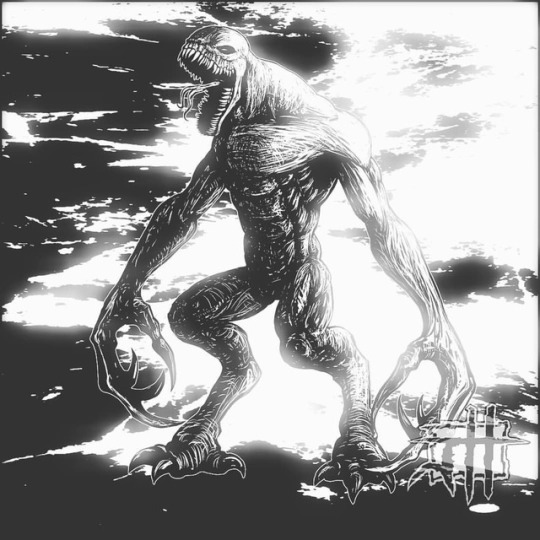
Updates. More reptilian. #gaming #ttrpg #osr #retroclone #LabyrinthLord #dnd #monster #monstermanual #swordsandwizardry #jeremyhartillos #creaturefeaturequarterly #rpgart #rpgillustration #illustration #monsterdesign https://www.instagram.com/p/Bqcvw61j-kY/?utm_source=ig_tumblr_share&igshid=jzjha0ajh469
#gaming#ttrpg#osr#retroclone#labyrinthlord#dnd#monster#monstermanual#swordsandwizardry#jeremyhartillos#creaturefeaturequarterly#rpgart#rpgillustration#illustration#monsterdesign
1 note
·
View note
Text
The Zone has different rules
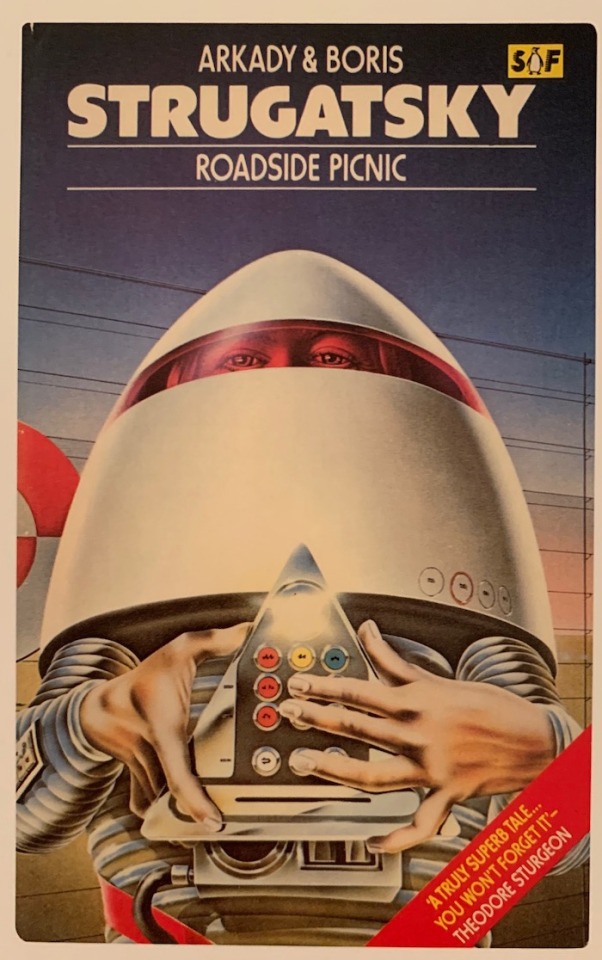
Posting about this mainly as a reminder to self that it is a thought I want to think more on.
Also because it dovetails with notions Liam and I discussed over on Toa Tabletop, about how you can portray subjective fantasy worlds in TTRPG play---essentially: Oh, the party visits a culture with different mores / cosmology / etc? The actual rules of the game change.
===
Over on cohost, Amanda Franck poses the following question:
How do you make rules/problems for a place that is supposed to be inexplicable & mutable & impossible to understand (like fairyland or dreamland or roadside picnic zone)? ... My experience in playing through a few of people's dreamworlds where anything can happen has been mostly bad, because it's hard for all the players to understand the physical space that they are in, and frustrating to try to interact with a world that doesn't respond in a sensible way.
To which Scampir proposes:
If i really wanted to get the point across that an area was under the influence of different logics, I would just use a different game for that area. Maybe a smaller game just so it can be quickly integrated.
(Attribution to make it clear I'm building on other folk's ideas.)
===
So here's my idea:
Say you are running a campaign using D&D or retroclone. Your players encounter Faerie / the Dreamlands / Area X / the Zone.
When they slip into its borders, you tell them things are gonna getting weird. But you don't give them new character sheets. You just start organically calling for resolutions and mechanics from a game that isn't D&D.
Maybe a dice-pool game like RuneQuest or WFRP. Or Blades in the Dark:
GM: "So you rest? Okay, tick your healing clock."
Player: "Wait, wtf's a healing clock?"
This does a few things:
Discombobulates players. They have to figure out the ways in which assumptions of reality differ.
The choice of new ruleset you use signals the specific ways that this specific Weird Zone is weird. (Use a game with more story-game mechanics and you imply that the Weird Zone has a different relationship with causality.)
Players learn / jot down / use new mechanics on the same old character sheet---implying that the Weird Zone changes their characters.
Abilities / mechanics they pick up remain when they leave the Weird Zone, and return to boring normal D&D rules. A signal that the Zone has changed them in uncanny ways.
Player: "Hey, I've still got this '+1d to gather info' ability, right? And this counts as a gather info situation? Can I roll two d20s and total them?"
GM: "Yes."
===
So yeah: bashing incompatible game systems together.
Maybe that's a fool's errand. But I feel like it should be possible to create a procedure for ruleset mash-ups, so that there's a process to follow? Best practices for how it happens.
Consistency at the layer of play culture, even if there isn't consistency at the layer of mechanics.
I'd like to pursue this more, because---as mentioned above---I'm interested in portraying subjective fictional worlds, and this "different place, different rules" thing seems like one way to do that at a conceptual level.
Also I like it because jury-rigs and mash-ups seems quintessentially "rulings not rules"-sy, to me. It seems to be in that OSR-y spirit.
===
( Image source: https://sciencefictionbookart.com/roadside-picnic-arkady-boris-strugatsky-1979/ )
45 notes
·
View notes
Text
You can just do it with either RT itself or modern retroclone like Renegade Scout, the wargame statline has all the stats you will need, have it be smaller scale, where you got only one/two players, and game master, run scenarios like wargame scenarios from the rulebook and players playing smaller bands of warriors, roleplaying their leader in non-combat scenarios, as early 40k is very much very TTRPG like.
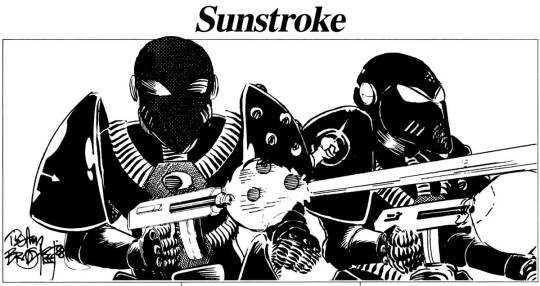
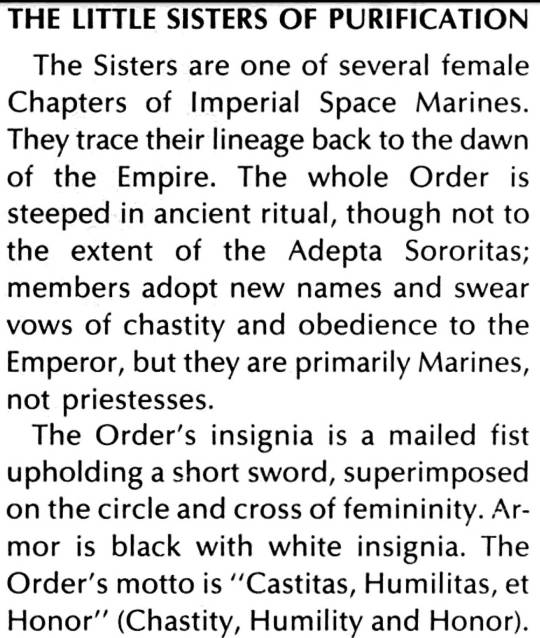
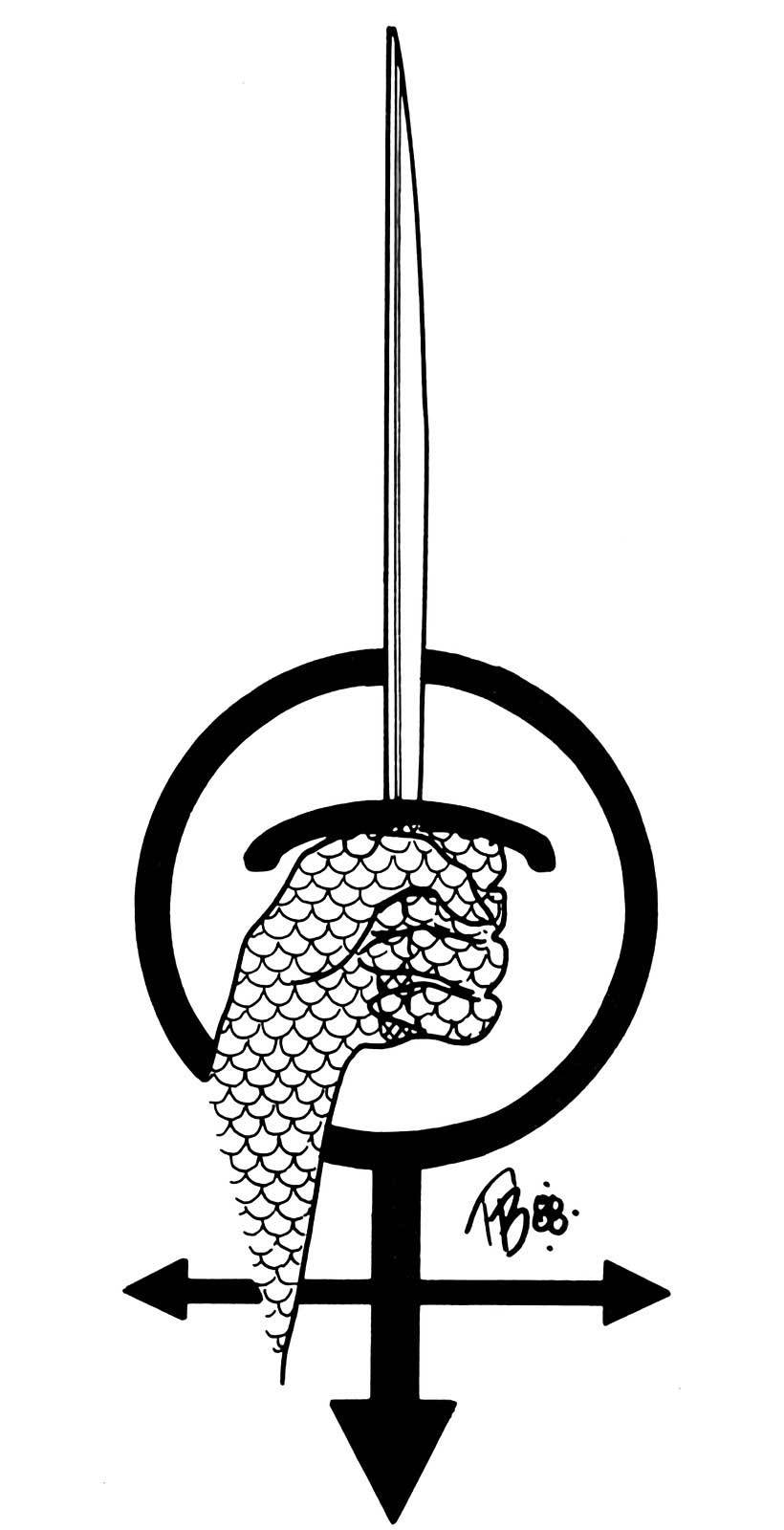


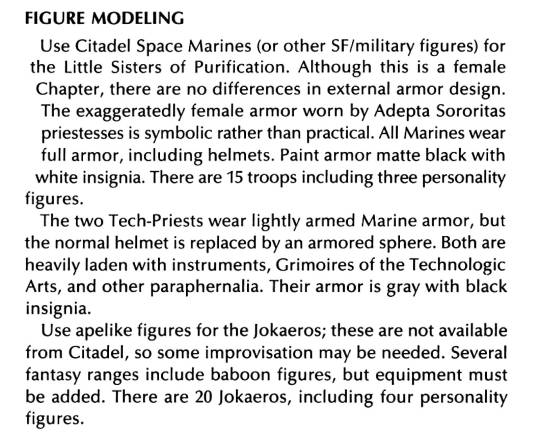
The Little Sisters of Purification, space marine chapter from Roger Hamlin's scenario "Sunstroke" in Challenge #36, "GDW's Magazine of Futuristic Gaming," 1988, illustrated by Tim Bradstreet.
Early White Dwarf had run many articles about Traveller; here GDW returns the favor in their own magazine that was a successor to The Journal of the Traveller's Aid Society. This "refereed Warhammer: 40,000 scenario for a small unit of Space Marines and opponents" is just one example of the highly imaginative directions players were taking 40K in the Rogue Trader days. This one has a lot of backstory and suggested modeling to run it as written -- 15 space marines from a new chapter, 20 Jokaeros (one of whom actually is a vampire in disguise), and an ancient Slann base on an asteroid protected by forcefields inside a sun.
854 notes
·
View notes